
Lake County is one of the 36 counties in the U.S. state of Oregon. As of the 2020 census, the population was 8,160. Its county seat is Lakeview. The county is named after the many lakes found within its boundaries, including Lake Abert, Summer Lake, Hart Lake, and Goose Lake.
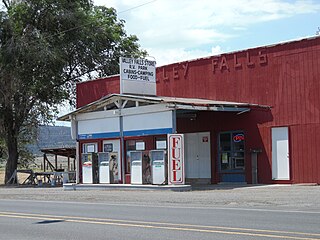
Valley Falls is a small unincorporated community in Lake County, Oregon, United States. The settled area is located at the junction of U.S. Route 395 and Oregon Route 31. The community is named for a small falls on the Chewaucan River just north of the occupied site. East of Valley Falls, the cliff face of Abert Rim overlooks the community.
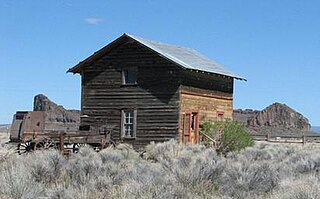
The Fort Rock Valley Historical Homestead Museum is located in Fort Rock, Oregon, United States. Opened in 1988, it is a collection of original homestead-era buildings including a church, school, houses, homestead cabins, and several other buildings assembled in a village setting. The structures were moved to the museum site from various locations around the Fort Rock Valley, named for volcanic landmark Fort Rock. Most of the buildings contain historic items used by local homesteaders including furniture, dishes, household products, and tools. The museum is open for self-guided tours from Memorial Day weekend through Labor Day weekend.

The Goose Lake Valley is located in south-central Oregon and northeastern California in the United States. It is a high valley at the northwestern corner of North America's Great Basin. Much of the valley floor is covered by Goose Lake, a large endorheic lake that straddles the Oregon–California border. Native Americans inhabited the Goose Lake Valley for thousands of years before explorers arrived in the 19th century. The pioneer wagon route known as the Applegate Trail crossed the Goose Lake Valley on its way to southern Oregon. At the south end of Goose Lake, the Lassen Cutoff separated from the Applegate Trail and headed south toward the Sacramento Valley. Today, Lakeview, Oregon, is the largest settlement in the valley. Livestock ranching and lumber mills are the valley's main commercial activity. The Goose Lake Valley offers a number of recreational opportunities including hang-gliding, hunting, fishing, and birdwatching.
The Dry River is an intermittent tributary, 88 miles (142 km) long, of the Crooked River in the U.S. state of Oregon. The stream arises near Hampton Buttes north of Hampton and U.S. Route 20 between Brothers and Riley in the Oregon High Desert. Beginning in eastern Deschutes County near its border with Crook County, it flows generally northwest along the Deschutes–Crook county line, crossing briefly into Crook County before turning slightly south and returning to Deschutes County. Along these upper reaches, it flows roughly parallel to the highway, under which it passes several times before turning sharply north near the Horse Ridge Research Natural Area, 19 miles (31 km) southeast of Bend. Continuing north and re-entering Crook County, it passes under Powell Butte Highway, Oregon Route 126, and Oregon Route 370 before entering the Crooked River 34 miles (55 km) from the larger stream's confluence with the Deschutes River.

The Oregon Maneuver was a large scale military training exercise held in Central Oregon in September through November 1943. The exercise was designed to test United States Army units prior to deployment in support of Allied combat operations in World War II. The maneuver included approximately 100,000 men. The major units involved in the exercise were all part of the army's IV Corps, commanded by Major General Alexander Patch. The exercise headquarters was located at Camp Abbot, south of Bend, Oregon. The maneuver included five specific training problems that engaged troops from a defensive Red Force and an offensive Blue Force. Following the maneuver the three participating divisions, the 91st Infantry Division, the 96th Infantry Division, and the 104th Infantry Division were sent into combat in the European or the Pacific theaters.
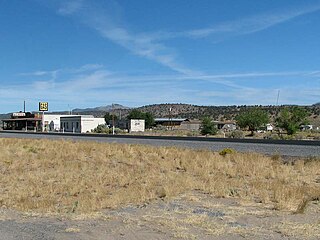
Hampton is an unincorporated community in Deschutes County, Oregon, United States. It lies about 60 miles (97 km) southeast of Bend, on U.S. Route 20, on the edge of the High Desert.

Raymond Robert (Ray) Hatton was an English educator, author, and long-distance runner. Born in England, Hatton moved to the United States in 1956 to attend college, earning degrees in education and geography from University of Idaho and the University of Oregon. He was an award-winning college geography professor for many years. Hatton wrote ten books on Oregon geography, history, and climatology. In the 1970s and 1980s, he won numerous Masters level running championships and set American records in several long-distance running events. Ran a Masters WR in the Mile at 4:26.0 in 1972. Hatton was inducted into the USATF Masters Hall of Fame in 2001.

The Catlow Valley is a basin in Harney County, Oregon, United States. It is a remote valley at the northwestern corner of North America's Basin and Range Province. The valley is named after a pioneer rancher, John Catlow. The area was used by Native Americans for thousands of years before European explorers arrived in the 19th century. Today, cattle ranching is the main commercial activity in the valley. The public land in the Catlow Valley is administered by the Bureau of Land Management. This public land offers a number of recreational opportunities including hiking, hunting, fishing, bird watching, and wildlife viewing.

Fossil Lake is a dry lakebed in the remote high desert country of northern Lake County in the U.S. state of Oregon. During the Pleistocene epoch, Fossil Lake and the surrounding basin were covered by an ancient lake. Numerous animals used the lake's resources. Over time, the remains of many of these animals became fossilized in the lake sediments. As a result, Fossil Lake has been an important site for fossil collection and scientific study for well over a century. Over the years, paleontologists have found the fossil remains of numerous mammals as well as bird and fish species there. Some of these fossils are 2 million years old.
Charles William Emanuel Jennings, known as Pop Jennings, was a businessman and Oregon state legislator. He was an early settler in the Chewaucan Valley in south-central Oregon, where he established the community of Valley Falls. Jennings was also a Democratic member of the Oregon House of Representatives for one term, serving from 1937 through 1938.

The lava bear is a variety of American black bear found in the lava beds of south central Oregon. The animal was described as a very small bear with wooly light brown fur. The few lava bears that were killed or captured were a little larger than a badger. It was once thought to be a separate species. However, scientists who examined the specimens determined that the animals were stunted due to the harsh environment in which they lived. Today, it is acknowledged that lava bears never existed as a unique species.

Glass Buttes are a group of volcanic mountains made up of two prominent peaks and several smaller hills. They are located in the remote northeast corner of Lake County between Bend and Burns in central Oregon, United States. Raising high above the high desert plain, the buttes are an important landmark in an area once known as the Oregon's Great Sandy Desert. The buttes are named for the numerous large deposits of obsidian found on their slopes. Today, most of the mountains and surrounding land are administered by the Bureau of Land Management. The mountains offer a number of recreational opportunities including rock collecting, hiking, camping, and hunting.

The Cline Buttes are mountains with volcanic origins that form three dome-shaped peaks located in Deschutes County in central Oregon. They are some of the eastern foothills of the Cascade Range. Situated on land administered by the Bureau of Land Management, the buttes are flanked on the east and west sides by two separate sections of the Eagle Crest Resort. On the highest summit, there is a Federal Aviation Administration site with an aircraft navigation beacon. The mountains have several hiking trails as well as a number of popular mountain bike routes.
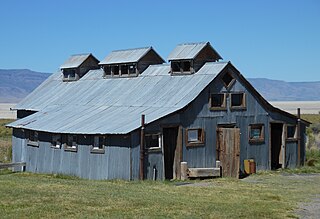
Summer Lake Hot Springs are natural hot springs at the south end of Summer Lake in south-central Oregon. They are artesian mineral springs with four surface sources. The springs have complex water chemistry. The temperature of the main source is approximately 123 °F (51 °C) with a water flow of approximately 20 US gallons (76 L) per minute. Over the years, the site has been developed as a rustic family bathing and relaxation resort. The hot springs are 124 miles (200 km) southeast of Bend, Oregon, near the small town of Paisley, Oregon.
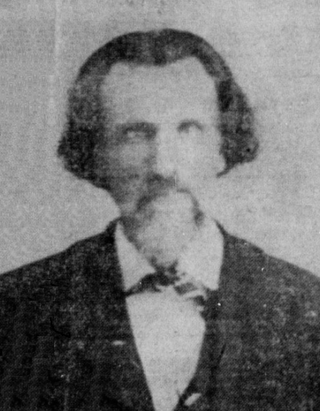
Francis Barnett Prine was an American pioneer who was one of the first settlers to homestead in the Ochoco country of central Oregon. When he was young, Prine traveled with his family from Missouri to Oregon's Willamette Valley over the Oregon Trail. He served in the 1st Oregon Volunteer Infantry Regiment during the American Civil War. Prine later moved to the Central Oregon, where he established several businesses in what became Prineville, Oregon, a town named in his honor.

Cass Adelbert Cline was an American pioneer who was an early settler in central Oregon. Cline’s family moved to Oregon when he was a small child, settling west of the Cascade Mountains near Roseburg. As a young man, Cline moved to central Oregon and claimed homestead land along the Deschutes River. He later became a well-known dentist, property developer, and race horse breeder. Today, a waterfall on the Deschutes River, a nearby mountain group, and a state park bear his name.
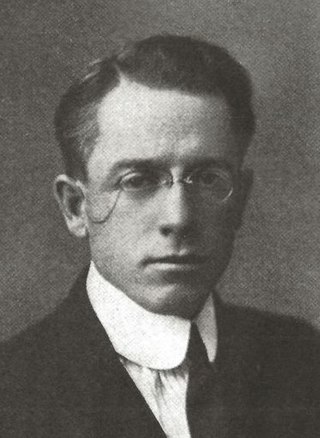
Vernon A. Forbes was an American attorney and state legislator from the state of Oregon. After graduation from law school in Minnesota, he moved to central Oregon and opened a law office in the city of Bend. Forbes was a Republican who served three two-year terms in the Oregon House of Representatives, representing Crook, Deschutes, Grant, Jefferson, Klamath, and Lake counties. He drowned during a fishing trip near the end of his third term in the legislature.

Fremont was an unincorporated community located in Lake County, Oregon, United States. The first homesteaders arrived in the area around Fremont in 1905. The population grew quickly, and the Fremont post office was opened in 1908. By 1915, the local population was declining rapidly due to a severe drought that dried up surface water and lowered the water table in the area around Fremont. Today, Fremont is a ghost town with no population and no surviving structures. The site is located approximately 5 miles (8.0 km) west of Fort Rock state park. The nearest inhabited place is the small unincorporated community of Fort Rock, Oregon, which is 6 miles (9.7 km) southeast of the Fremont townsite.

Fleetwood was an unincorporated community located in Lake County, Oregon, United States. The first homesteaders arrived in the area around Fleetwood in 1905. The Fleetwood post office was opened in 1913. By 1920, the local population was declining due to a severe drought that dried up surface water and lowered the water table in the area around Fleetwood. Today, Fleetwood is a ghost town with no population and no surviving structures at the townsite. The site is located approximately 10 miles (16 km) east of Fort Rock state park. The nearest inhabited place is the small unincorporated community of Fort Rock, Oregon, which is 9 miles (14 km) west of the Fleetwood townsite.






















